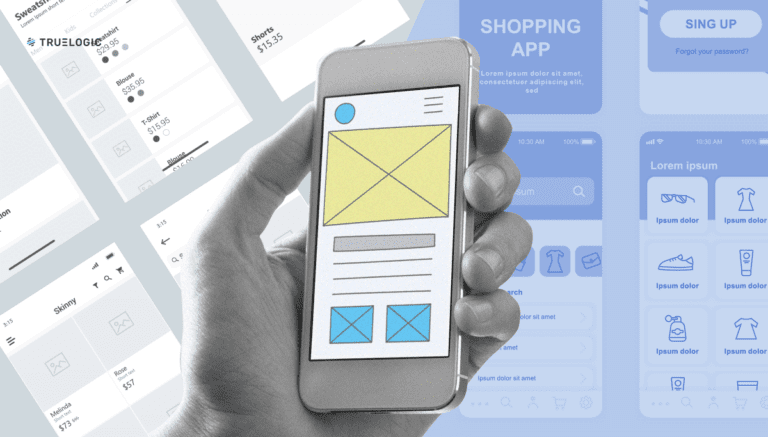Truelogic DX Podcast Ep 6: Shopee vs Lazada: Web Design Battle of E-Commerce Giants

Shopee and Lazada are now the biggest e-commerce platforms in the Philippines. The digital acceleration in the country increased exponentially during the pandemic.
According to Statista, as of the 3rd quarter of 2021, Shopee PH has more than 73.65 million monthly web visits making it the most visited B2C e-commerce site in the country. Coming second was Lazada with 39.43 million monthly visitors.
A study conducted by Iprice also showed Shopee reigned as the most actively used mobile e-commerce app in Southeast Asia and the most visited e-commerce platform with 200 million desk and mobile visitors while Lazada is the second highest, garnering an average of 174 million visitors.
But how do these two giants perform in terms of web usability and design? Learn more about the web designs of Shopee and Lazada in the current Digital Landscape in our Truelogic DX – The Podcast Edition.
Podcast Transcription
Today, we’re talking about the battle of the marketplaces, Shopee and Lazada. Are you guys ready to rumble on this episode of the Truelogic DX podcast? On the orange corner, we have Shopee, on the blue corner, we’ve got Lazada.
And when we were doing some of this research and you know, part of it is to give you guys what the experience of a digital marketer is like in some of the details that we look at that the normal audiences wouldn’t look at. But we want to evaluate how these two websites compare–apples to apples–in terms of performance gaps, in terms of usability, in terms of design, just so that we’ve got a more nuanced conversation.
Now to keep this from becoming, you know, a monologue, I’ve invited two guests from our team, they are some of our creative experts at Truelogic. I want to welcome Ant, our graphic designer, and Gab, our web designer of Truelogic.
E-commerce in the Philippines
I do remember a time when e-commerce was not popular in the Philippines in 2000. In 2001, I was waiting for local brands to start getting mature and then Lazada came along. Then they introduce us to the first real mainstream e-commerce shopping experience. And I remember when I saw it, there’s no way these guys are making money, which they were not.
I think for most people, they’re not aware when you launch startups that are this big, that usually have venture funding, they are expected to be at a loss because what they’re looking for is adoption, which I think Lazada did remarkably well, that led to their acquisition in 2016. And that was by Alibaba. And then more Filipino brands, more Filipino merchants, and even mainstream brands started adopting Lazada and Shopee. Like today, I don’t know of any main brand or mainstream brand that does not have Lazada as a channel partner.
The impact of pandemic on the state of online shopping
Especially now that we are in the middle of the pandemic, both platforms have been very useful. Aside from it being convenient, I think it’s a nice notch to both that almost every major brand you’re looking for is there. You can even buy soy sauce. For someone who’s a little bit lazy when it comes to grocery shopping. I’d rather just browse through my phone, go online and buy my stuff.
The biggest help was when we were all locked down and I needed some of my essentials. When I say essentials, for my addiction, like my toy collection. Greenhills is closed. I can’t do my normal walks, you can’t take a look at what inventory people have in Greenhills. But it was also another way, I think, to support the merchants that I frequent when I go to Greenhills. I just looked for their Lazada stores and I made the purchases online. Some of them actually have their own websites, which I will also order from, but when it’s available there, I do so, ‘cause it’s easier to do comparisons between them. Toys R Us, Toy Kingdom. So it was a very safe, convenient way. Like I didn’t have to wait for all the lockdowns to end to make sure that I managed to continue with my collection. That’s one.
The other is for very niche products, right? Like the Philippines doesn’t have a lot of things like super available. That would be more common in other places. I’ll give you guys an example.
Do you know what an E12 LED light bulb is? So if you go to Lazada, you will find dozens of merchants that sell E12 LED light bulbs. E12s are, they’ve got the super small sockets on electronic fake candles or fake candelabra, those are the bulbs that go on it and go inside.
So light bulb sockets are E12s, E14s, E16s and whatnot, but E12s are, they’re hard to find. And I light my house up, like a Christmas tree on Christmas, and I bought all of these lanterns that use E12 bulbs, but the E12 bulbs they came with were the old incandescent ones and, you know, I don’t own shares of Meralco so I clearly don’t want to run them on incandescent bulbs.
So I have to look for LED replacements plus, you know, it’s more earth-friendly, but you cannot find them in Wilcon and you cannot find them in Home Depot and ACE Hardware. You cannot find them anywhere. And so Lazada becomes a good channel for you to find it. Shopee also, by the way, has merchants that sell it.
And you’re not talking about cheap, anonymous lightbulbs. You’re talking branded ones like Samsung right? Or other light manufacturers that are available with them, but are not available in mainstream. So I think that’s the largest convenience that they create.
Shopee vs Lazada
Let’s talk about what I would call the upstart because I think Lazada is the one that started it all in the Philippines. Shopee actually sort of benefited from the mainstream following that they had created.
Lazada comes into the market, sort of, I think puts people’s e-commerce experiences on training wheels, gets to mainstream volume and then three years after that Shopee comes into the market, right? And Shopee belongs to Tencent or at least back by Tencent, and it’s headquartered in Singapore, but they did give Lazada a run for their money.
Like they came on very strong, the kind of marketing I saw with Shopee was similar to Unilever launching a product. That kind of marketing ubiquity is what they did in order to get people to adopt it.
My expectation and this is where we’re going to get to the more geeky data about these two is that because Lazada had a head start, I was fully expecting the data to show us that the adoption on Lazada, the traffic on Lazada, the referrals to Lazada, was going to be more than Shopee. But, you know, that just wasn’t the case. So I’m going to dive in through the technical elements of both websites, right. And full disclosure for the people that are listening. In order to do the comparison, we use tools like SEMrush and similar websites, just to compare them apples to apples.
What the data shows
So according to this data, across the span of three months where Lazada drives traffic for three months of 127 million, Shopee does 240 million within the same period. So nearly double. To me, that’s like, that’s incredible. So if you broke this down on a month-by-month basis, it would look like Lazada does about 40 million in monthly visitors and Shopee does close to 80 million in monthly visitors. So super unexpected. The other one though is in terms of device usage, this one was actually, I think, a bit sort of expected.
Full disclosure though, I find stuff on Shopee that I don’t find on Lazada. Inventory size-wise I think Shopee trumps them. I also think merchant size-wise, they also trump Lazada. And I think that’s why you find stuff on Shopee you don’t find in Lazada.
1. Engagement Rate
How many items do you wind up impulse clicking in seven minutes versus five minutes? And that could be the difference between a shopping cart of 500 pesos and 1500 pesos. That could be the difference between you moving an item of high inventory margin versus low inventory margin. Clearly what’s driving that or the number of pages per visit, according to Similarweb, the number of pages that an average Lazada browser will go through is about five to six pages.
And on Shopee it’s 8! I probably also fall in this category because I’m the guy that looks at the search results and to go like opening a tab, opening a tab, opening a tab and before you know it, you’ve got 12 tabs, right, in one visit. So to me that makes sense. And their engagement rates are not bad right? Their engagement rates are almost 50%. Lazada bounces people a bit more than Shopee does. So Shopee’s engagement rate is about 60%. Lazada is about 40, 47, 48%. So that’s still pretty neck and neck, but yeah, I had no idea that the distribution was going to be like that.
I did get surprised at the traffic share that was coming from other regions. And so when I first saw this, I was going, like, why? And then I remember, oh yeah, but it might because the Internet doesn’t care where you are. The Internet doesn’t care, I guess in the same way that I keep an Amazon.de account because some of my cherished nephews are in Germany. And so a week or two before their birthdays, I buy stuff from Amazon and I ship it to them and they just get surprised or their mom tells them.
And, you know, they pretend to be surprised, but I keep an Amazon.de account. So then whenever it’s anybody’s birthday in the extended family in Germany, I send them gifts and I just buy it on Amazon and it’s prime. So my shipping is free and the shipping is pretty expedited. So it’s, it’s worth it. But I guess by the same token that I would keep an Amazon account.
But some of these are a bit surprising. I didn’t even think about where the traffic came from. But of course the majority of the traffic lion’s share comes from the Philippines. One of the most pleasant surprises to me was actually, this is sort of where I think the pandemic sort of comes in.
And it gives the gift of forcing people to adapt to, you know, “new normal” for better or for worse. But I had Lazada and Shopee deliveries to my house, once or twice a day. And it was the women in the house that were driving. The men were getting orders like once every three months, once every two months. I think I read from Facebook’s data that the majority of the targeting for e-commerce actually targeted women.
I think about 60% of them targeted women. The lion’s share of their traffic is coming from direct, which is not a surprise, right? So not a lot of it is coming from organic search. It’s not people doing searches. I’ve been going into their web stores. A lot of it is people typing in Lazada, people typing in Shopee and then performing their searches inside the portals, which sort of made sense because prior to the pandemic, and a lot of people don’t seem to be aware, the second largest search engine was Amazon.
The first one was Google. 60% of product searches happen on Amazon. After the pandemic, they weren’t, I think there are now fourth or fifth. The second largest search engine now is YouTube. So it’s now Google, YouTube, Facebook.
And it used to be Google, Amazon, Facebook, YouTube, and whatnot. So the pandemic changes the order in which people perform the search. In the same way that people go to Amazon and search for products, that’s also, I think, the same behavior that people do when it comes to Shopee or Lazada.
2. Website Navigation
Let’s talk about navigation like navigating around products, navigating the website, looking for the right product. Like whether in the app or whether in the store.
Lazada feels like a cleaner experience. It’s a bit more straightforward. The iconography for me is just the right size. I will say something about usability, which I’m not a fan of. Like, for example, I like how they categorize the items on flash sale. Here are the most popular stuff that people are buying now.
Are there specific product categories? Although I think both brands, no? People are probably just going to hit the search bar and go to the product anyway. Which is why it’s a bit cluttered. But one of the things that I am very sensitive to in terms of any experience is when brands pretend to customize experiences for me and don’t, right? Like, to me, that’s a big deal.
In Shopee, first, you’ve got segmented navigation. You have the sections for the promos in a row. You have navigation for rewards, free shipping and promos. And under that you have the big promo banner, like promos and stuff. The promos on Shopee are actually a lot more in your face. Uh, there’s the bright banner. And then there’s the message that they’ve got, like their 10th birthday sale that’s going on. There’s no room to breathe because of the bombardment of promo imagery.
3. Shopping Experience
My shopping experience in Lazada for me has been easy. Like looking for PC parts, I can only speak for PC parts since I’m a PC gamer. Shopping in Lazada for you has been easy. As I mentioned a while ago, you can easily filter like the parts you need, let’s say you search for a monitor merchant.
You can look in the filter, which kind of monitor brand you want, how many stars, like does the monitor have four ratings? So having that kind of filter in Lazada has assisted me a lot in shopping for PC parts.
Checking out, it’s kind of hard. Because some of the fonts are small. Like sometimes I have these instances wherein I checked out Lazada and I forget to apply for a voucher because the voucher section or the voucher is not there.
Some of the elements in the checkout section are not really balanced. So like you tend to miss out on things. Sometimes I even have a tendency. Let’s say I’m buying PC fans, but sometimes due to the unbalanced elements I almost check out four pieces. So like if they could balance the elements well, it’ll be easier for me.
Majority of my shopping on mobile, I would look at in the perspective of a mobile user. So for me, I prefer the experience I have in Lazada.
For Shopee though, I haven’t checked out the mobile version, but I’m looking at the desktop version right now. It’s organized as much as possible. You can easily see the voucher section. You could easily see the information about the voucher and shipping promos and even have a separate section for the price, the quantity.
4. Security
The only reason I have developed a preference for Lazada and not Shopee is because their OTP works once in a blue moon. Like when I do transactions on Shopee, it sends me an OTP, which I appreciate. By the way, I love brands that will send me an OTP before they proceed with the transaction. But, you know, it’s an issue if I can only get that OTP to work twice in two years.
I think checkout experience-wise both are pretty good. Like, I don’t remember having to like the fact that you can save your delivery address. Although I have misshipped, for some reason I thought I set the delivery address to my home and then it will always default to the office. And so stuff that I expect to come to the house comes to the office. Luckily I come to the office every day. That’s still happening. So it’s not very intuitive.
The other thing that I don’t think is very full disclosure is there are times where it’s not very obvious that the seller is from offshore, like nothing against offshore merchants. It’s just that if I want an item urgently, like let’s say the charger for my device broke and I need to replace it cause my battery will last, I don’t know, a day, two days. I don’t want to wait for something for a week, two weeks. And so I wish that they were more openly disclosed like they do with eBay. If it comes from within the Philippines, you know? Like blue, right side selection of the merchant.
So Shopee, my shopping cart size is large, you know, you want to make that OTP work, let us know.
5. Website Traffic
Let’s try to break down why Lazada and Shopee are driving so much traffic to their website. Again, like one of the things I think we talked about was how we were all surprised. Like, especially since the three of us do more transactions on Lazada than Shopee, I think our natural assumption was okay, then more people would probably use Lazada than Shopee. And the data was that, no, like half.
Lazada has almost just about 50% of the amount of monthly traffic the Shopee has. And you have to wonder what’s causing that. So we sort of broke it apart to try to find out where they were getting their top traffic from. And I think I mentioned earlier, organic is not a majority of the traffic for these two websites, it’s a big driver, but it’s not the largest driver of traffic.
Brand awareness is the largest traffic driver. So all of those ubiquitous YouTube ads, like the YouTube ads that you will see twice in one video, and the videos, like five minutes.
So, we did break down the sources of traffic. And one of the interesting things is that a lot of the things that brands need to do are very neck and neck, except for the choice of where they put their advertising dollars.
To be visible, to be top of mind, to have a high brand awareness directly is the largest traffic driver. But when we saw where the traffic was, where the money was being driven to, right? We saw Lazada use the Google networks a lot, like the lion share of their budget is in the Google network. And that’s why they’re very ubiquitous when it comes to the Google shopping carousel at the top, they’re also very visible when it comes to the search network ads.
They’re also very visible when it comes to the ads following you around. So the Google ad network, very utilized by Lazada more than Shopee.
Shopee, though, does use a lot of advertising networks like third-party advertising networks. If we take a look like if I break it apart again, Similarweb data, third-party advertising network utilization for Shopee is 71% and it’s only 28% for Lazada. So they’re clearly tossing in more research, more resources, but flip that around to Google and you’ll see that most ad destinations that Lazada utilizes 78% of the time Google and only 21% of the time, other ad networks.
So that’s pretty interesting, like the fact that one drives traffic through multiple independent ad channels, ad networks. And one is tossing a lion’s share essentially with Google. I think there are pluses and minuses to each strategy. I think the Shopee people can be very proud. They’re live, they’re driving double the traffic.
Like I would think about even YouTube, like, share of advertising on YouTube, Lazada versus Shopee only, the YouTube advertising that Lazada does is about 31%. And Shopee is about 68. So they’re more ubiquitous in YouTube, Yahoo, you know? Sure. Beyond Yahoo, just for covering your base. So, no, I’m sorry. No offense.
We love you, but yeah, I’m on Yahoo. Lazada is putting in the due diligence, like making sure their bases are covered, that they’re advertising on that network. So in my opinion, terrific.
Conclusion
So just to wrap it up, a couple of things that I would probably want to say just as my first takeaway here is just because you’ve got a couple of anecdotal pieces of experience does not mean that that is the general summary of a population.
So you’re in the three guys that are Lazada aligned does not mean the general population of the Philippines is aligned. Data is proving us wrong. Shopee is doing twice as much as Lazada. I also think we made some comments on experiences. Lazada, if you’re listening. Shopee, if you’re listening, right? Like default addresses, let’s make it better. That OTP, please make it work. Don’t unlink our mobile wallets.
I think the return experiences on both platforms are still painful. I get more return experiences on Lazada, but probably because I order more from Lazada than I do at Shopee.
But so far, those have not been easy experiences. Like to the point that I feel there is a deliberate attempt to hide the data, to manage the return. So, but thank God, the merchants that I knew, we had the one more reason to work with a Lazmall or an official merchant store is because they make that process easier for you.
Last bit is how these guys are driving your traffic. Clearly they’re driving two different strategies. Like you can always make the assumption that, oh no, they’re both ubiquitous on YouTube and both ubiquitous on the Google ad network and both ubiquitous on third-party networks. But the truth is contrary to that.
Clearly they are putting in large amounts of resources into being top of mind for the Filipino audience, but they’re hedging their bets in different channels in different strategies. So, yeah, so, you know, just goes to show they’re very similar, but they’re not the exact same animal. I think the people running the brands know that they each both create distinct value. I think they manage to keep their specific types of users very loyal. So good job on them.
We’re huge beneficiaries of the pandemic. Well with brands made, made the lockdowns just a bit more bearable because they were there. I cannot, I don’t even want to imagine what it would have been like locked down and you couldn’t get your stuff to your house.
I want to thank you guys for joining me today and I want to invite everybody else to join us again on the next Truelogic DX podcast.








